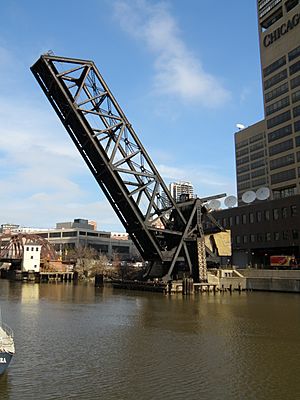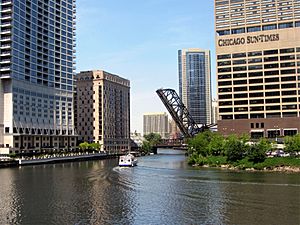Kinzie Street railroad bridge facts for kids
Quick facts for kids Kinzie Street railroad bridge |
|
|---|---|

Kinzie Street railroad bridge permanently locked in the raised position
|
|
| Crosses | Chicago River |
| Locale | Chicago |
| Official name | Chicago & North Western Railway, Kinzie Street drawbridge |
| Other name(s) | Carroll Avenue bridge |
| Heritage status | Chicago Landmark |
| Characteristics | |
| Design | bascule bridge |
| Total length | 195.83 feet (59.69 m) |
| Width | 41.7 feet (12.7 m) |
| Longest span | 170 feet (52 m) |
| History | |
| Construction begin | December 1907 |
| Opened | September 19, 1908 |
The Chicago and North Western Railway's Kinzie Street railroad bridge (also known as the Carroll Avenue bridge) is a single leaf bascule bridge across the north branch of the Chicago River in downtown Chicago, Illinois.
At the time of its opening in 1908 it was the world's longest and heaviest bascule bridge. Previous bridges on the same site included the first bridge to cross the Chicago River, Chicago's first railroad bridge, and one of the first all-steel bridges in the United States.
The Chicago Sun-Times, the last railroad customer to the east of the bridge, moved their printing plant out of downtown Chicago in 2000, and the bridge has been unused since. It was designated a Chicago Landmark in 2007.
The bridge is lowered once a year and inspected by crew driving a Hi-Rail truck, and is still in "active" status.
History
River traffic and railroad traffic were increasingly in competition with each other. In October 1879 a disaster was narrowly avoided when a seven-coach passenger train with 800 people on board approached the open swing bridge too fast and was barely able to stop in time, ending up with its front wheels hanging off the approach road over the river.
Meanwhile, boats on the river were getting larger and finding it increasingly difficult to navigate the bridges at the mouth of the north branch, so the Army Corps of Engineers ordered the clearing of three swing bridges near Kinzie Street that were obstructing river traffic. Therefore, in 1907 construction started on a new bascule bridge that would allow more space for boats to pass by on the river. The bridge was designed to also carry two railroad tracks across the river.
Proposals for reuse
In the 1970s it was suggested a light rail line along the spur to connect Chicago's downtown stations with the River North neighborhoods. In 2008 the City of Chicago Department of Transportation commissioned an alternatives analysis to look at a proposal to create a transit link using the Union Pacific train tunnel running under the Apparel Center, the Merchandise Mart and other buildings east toward North Michigan Avenue.
The proposed Carroll Avenue Transitway would include the retrofitting of Kinzie Street railroad bridge to carry buses or trams.
Images for kids
-
Night view looking north from Lake Street bridge showing Wolf Point and Kinzie Street railroad bridge. Among the buildings and structures shown are (left to right) Left Bank at K Station (300 North Canal), 333 North Canal, Kinzie Street railroad bridge, 350 North Orleans, Merchandise Mart, 300 North LaSalle, Franklin Street Bridge and part of 333 Wacker Drive.
-
Bird's-eye view of Wolf Point viewed from the east as it appeared in 1893. The 1879–1898 swing bridge is visible in the top right of the drawing.








